3:計画はどんな内容か 3-3
3-3.物質循環型のゴミゼロ地域を目指します。
3-3-1.ニセコ町地域の物質循環と廃棄物排出はどのような状態か?
循環型社会を創るためには、私たちの地域でどれだけの資源を採取し、消費し、廃棄しているかを知ることが大切な前提となります。このような物質の流れを「物質収支(マテリアルバランス)」と言いますが、ニセコ町の物質収支は、基礎的なデータが不備なことから正確には把握できませんが、全国の物質収支を概観することを通じて、ニセコ町の物質循環の特性を推測することにします。(『平成13年度版循環型社会白書』環境省より)
(1)資源、製品等の流入量と流出量のバランス
日本に入ってくる資源や製品の量に比べて、日本から出ていく製品等の物質量は約7分の1で、アンバランスな状態となっています。特に、日本における窒素化合物による地下水や大気への負荷はとても大きいのですが、これは諸外国から大量の窒素酸化物が輸入されていることが原因となっており、結果的に生態系における窒素の健全な循環が損なわれています。
ニセコ町の場合は畑作の割合が大きいものの、約半年は雪の下にあることから、窒素過多の心配は本州より少ないと推察されます。しかし、今後の一層の調査と監視が求められます。農業は本来、私たちの生存に必要な食料を自然生態系との折り合いの中から生み出し続けている営みで、自然界と人間社会の間の物質循環や、地域経済としての物質循環を支え続けてきました。有機肥料は、そのもっとも凝縮された循環物質のひとつです。その意味で、農業は物質循環の基盤のひとつだったと言えます。しかし、近代農業が化学肥料や農薬を多用することによって、循環物質の量的なバランスが崩れたり、循環できない物質が多く残留するようになって、農業自体が物質循環の阻害要因となり始めているのも、現実です。ニセコでとれた作物が、かつてのように私たちの地域で多く消費されるのではなく、遠くの都市の市場を経由してから貫流したり戻ってこなかったり、という今日の大規模な市場経済も、物質循環を妨げています。
そこで、農業が再び物質循環の基盤に立ち返るために、循環できる適正バランスの有機肥料成分を活用し、循環できない化学成分を限りなく減らしたクリーン農業をめざします。そして、そのようにして作られた農作物がニセコの地域市場を循環する割合を増やし、「地産地消」(注21)の仕組みを目指す必要があります。
ニセコ町の場合は畑作の割合が大きいものの、約半年は雪の下にあることから、窒素過多の心配は本州より少ないと推察されます。しかし、今後の一層の調査と監視が求められます。農業は本来、私たちの生存に必要な食料を自然生態系との折り合いの中から生み出し続けている営みで、自然界と人間社会の間の物質循環や、地域経済としての物質循環を支え続けてきました。有機肥料は、そのもっとも凝縮された循環物質のひとつです。その意味で、農業は物質循環の基盤のひとつだったと言えます。しかし、近代農業が化学肥料や農薬を多用することによって、循環物質の量的なバランスが崩れたり、循環できない物質が多く残留するようになって、農業自体が物質循環の阻害要因となり始めているのも、現実です。ニセコでとれた作物が、かつてのように私たちの地域で多く消費されるのではなく、遠くの都市の市場を経由してから貫流したり戻ってこなかったり、という今日の大規模な市場経済も、物質循環を妨げています。
そこで、農業が再び物質循環の基盤に立ち返るために、循環できる適正バランスの有機肥料成分を活用し、循環できない化学成分を限りなく減らしたクリーン農業をめざします。そして、そのようにして作られた農作物がニセコの地域市場を循環する割合を増やし、「地産地消」(注21)の仕組みを目指す必要があります。
- 注21:「地産地消」=地域で生産された農産物や水産物などは、地域の消費者に優先的に消費してもらうような流通の仕組みを指します。また、消費した後の生ゴミを地域の農業生産者の堆肥として活用してもらうことによって、地産地消は地域内循環の仕組みを形成します。
(2)再生利用率
日本に入ってくる資源や製品の量に比べて、日本の再生利用量は11%程度しかなく、極めて低い水準にあると言わざるを得ません。
一方、ニセコ町における廃棄物のリサイクル率(あるいは資源化率)は、全国、全道、あるいは倶知安町をのぞく周辺地域と比べると高い状況にあります。
指標J=資源化率(=中間処理に伴う資源化量/ごみ処理量)(ブラフ)
一方、ニセコ町における廃棄物のリサイクル率(あるいは資源化率)は、全国、全道、あるいは倶知安町をのぞく周辺地域と比べると高い状況にあります。
指標J=資源化率(=中間処理に伴う資源化量/ごみ処理量)(ブラフ)
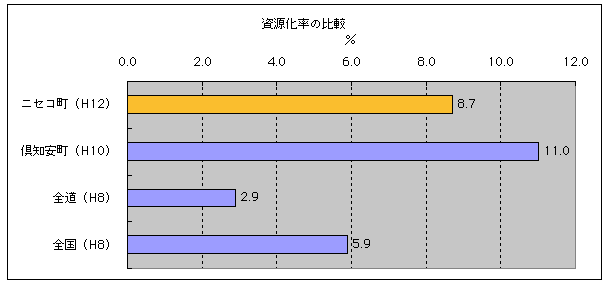
(3)総廃棄物発生量
日本の産業廃棄物、一般廃棄物の発生量は高い水準で推移していますが、ニセコ町においては、観光客などが排出する廃棄物を含めると、依然として全国平均以上の高い水準にありますし、データには現れない隠れた廃棄物(不法投棄)を含めると、一層高い水準になります。
- 指標K=廃棄物の処理量(グラフ)
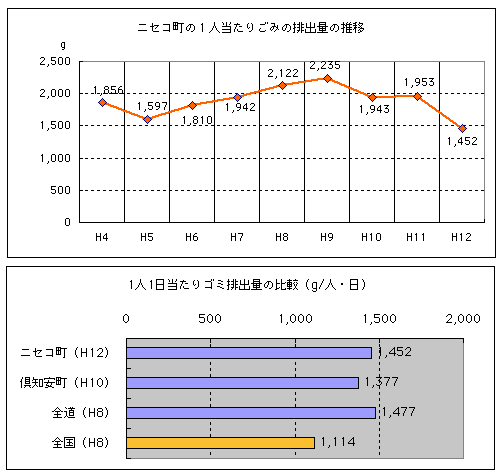
(4)エネルギーの消費
日本のエネルギー消費は高い水準にあります。ニセコ町の家庭から排出される二酸化炭素を「環境家計簿」によって推計した結果、平均世帯(2.35人)当たり年間1.98トン炭素換算(平成12年度)、となりました。これは、道央圏の都市(例:千歳市)とほぼ同じ水準です。特に、ガソリン消費の割合はニセコ町の方がかなり大きく、マイカーに依存しているライフスタイルの実態を反映しているものと考えられます。
- 指標L=家庭の二酸化炭素排出量
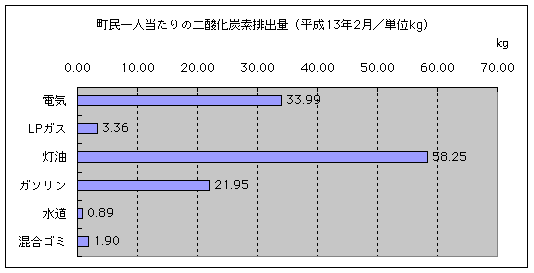
(5)資源採取に伴って生じる「隠れたフロー」
資源を採取する場合、使用する資源以外の物質も採取されてしまうことがあって、それはそのまま廃棄物などとして排出されますが、これらを「隠れたフロー」と言います。これは鉱工業にともなって発生する割合が高いのですが、一般の統計には表れないので実態把握が難しいのものです。ニセコ町の場合は、建築土木工事における土砂や建材の端材等から生ずるものの他に、農産物におけるハネ品の発生と廃棄処分にも「隠れたフロー」が潜んでました。しかし、農産物のハネ品などは、近く稼働が予定されている真狩村の炭化工場で融雪剤にリサイクルされる計画があるなど、隠れたフローの資源化に大きな展望が開けてきました。
3-3-2. 循環型ゼロエミッション地域を創るための具体的な手だて。
(1)【必要なものだけ買って、大切に使う】最適消費と再使用(リユース)にもとづく持続可能なライフスタイルへの転換
今日の私たちの暮らしと環境の関係は、"大量生産、大量消費、大量廃棄"によって大きく決められています。これが環境汚染の根深い背景となっていることは、誰の目にも明らかです。そこで、生産して売っているから買うという流れを変えて、ものは大切に使い(リユース:再使用)、暮らしに本当に必要なものを必要な量しか買わない(購入自粛)、しかも環境の持続に役立つ商品だけを買う、という暮らし本位の商品社会をつくる必要があります。そのためには、私たちのライフスタイルを、環境負荷型・環境汚染型から、環境調和型に転換することが求められます。購入自粛と再使用(リユース)、この2つからライフスタイルの転換を始めましょう。
また、農業者と消費者がお互いに見える関係で市場が成り立つ「地産地消」も、最適消費社会の実現に大きな意義をもたらします。農家と家庭が農作物と生ゴミという二つの資源を交換する双方向の「地産地消」によって、最適生産、最適消費、最少廃棄のあたらしい地域経済をつくります。
また、農業者と消費者がお互いに見える関係で市場が成り立つ「地産地消」も、最適消費社会の実現に大きな意義をもたらします。農家と家庭が農作物と生ゴミという二つの資源を交換する双方向の「地産地消」によって、最適生産、最適消費、最少廃棄のあたらしい地域経済をつくります。
- 目標達成の手だてと重重点的な手だて
- ものを大切に使うライフスタイルを取り戻します。
- 自分で作れるものは、工夫して作ります。
- 暮らしに本当に必要なものだけを適正量だけ買う消費生活を取り戻します。
- リユースのための仕組みをつくります。
- 省エネルギーを押し進めます。→【重点的な手だて】
- 農業が資源の循環に貢献してきた役割を理解し、今後は地産地消(地場産品を地場で消費)の地域内循環の環を形成します。
- 再生品による地場商品を開発します。
- 目標値:低公害車導入率(公共機関)=30%
- 目標達成に向けた具体的な手だてと主体別行動計画
| 目標達成の手だて | わたしたち町民の行動項目 | コミュニティの行動項目 | 事業者の行動項目 | 行政(役場)の行動項目 |
| 1.ものを大切に使うライフスタイルを取り戻す | ・長持ちするような使い方の工夫・買い換えよりも修理・用途を替えて再使用入する工夫 | ・修理業の起業・製品の修理や再使用を可能にする商品情報の提供 | ・修理業、修理ボランティアへの支援策の検討・生活用品の用途替えアイデアコンクールなどの実施 | |
| 2.自分で作れるものは、工夫して作る | ・DIY(自分で作る)の試み・知り合いどおしでDIYの経験交流 | ・DIYのハウツー講習会の開催 | ・DIYのハウツー講習会への支援 | |
| 3.暮らしに本当に必要なものだけを適正量だけ買う消費生活を取り戻す | ・暮らしに不要な商品を調査し、不要商品を買わない暮らしをする・暮らしに必要なニーズを商店に発信する・冷蔵庫内食品の定期的な点検 | ・暮らしのニーズ調査にもとづく品揃えと在庫管理・消費者の目から見て本当に必要な商品を開発する仕組みづくり・商品の環境側面についての情報をもっと積極的に開示する | ||
| 4.リユースための仕組みをつくる | ・友人どおしで生活品の交換・ガレージセールやフリーマーケット、バザーなどの開催・リユース品に関する需給情報のネットワークづくり・リユースセンター(再使用品の交換センター)の運営 | ・地域での開催、あるいは開催支援・リユースセンター運営の仕組みづくり | ・リユースセンター設置への協力 | ・リユースセンターの設置と仕組みづくりおよび運営への支援 |
| 5.省エネルギーを推し進める【重点的な手だて】 | ・家庭における省エネルギー・住宅の高気密化・高断熱化・家庭への自然エネルギーの導入・アイドリングストップやエコドライブ、暖気運転の短縮・公共交通機関の利用 | ・事業所における省エネルギー・事業所の高気密化・高断熱化・事業所への自然エネルギーの導入・アイドリングストップやエコドライブ、暖気運転の短縮・低公害車の導入・商品の環境側面についての情報をもっと積極的に開示する | ・自然エネルギー導入の支援策の検討・低公害車の導入・低公害車の範囲に関する検討・省エネルギーに関する情報ネットワークの整備 | |
| 6.農業が資源の循環に貢献してきた役割を理解し、今後は地産地消(地場産品を地場で消費)の地域内循環の環を形成する | ・地場産品の優先的な購入(=地消)・産直ルートの自主開拓・地産地消を進める活動への参加、知恵出し | ・産直ルートの地域単位とりまとめの試み | ・地場産品の優先的な町内流通と町内販売・堆肥センターの堆肥の優先的使用・輸送距離の短縮化・地産地消の推進(観光一時滞在者も含めて)・バランスのとれた成分による、物質循環に適した土づくりの推進 | ・地産地消の仕組みづくりとブランド化、およびラベル表示システム・観光一時滞在者も含めた地産地消のシステムアップ・仕組みづくりに向けた、関係機関(農業、観光、商業、環境)の協議の場づくり・土づくりの支援・使用肥料や農薬に関する情報の地域内共有を進める |
| 7.再生品による地場商品を開発する | ・くらしの中から、商品ニーズを発信する | ・消費者からの商品ニーズを基に、商品開発を進める・地域に密着したコミュニティビジネスの起業化 | ・消費者と事業者を結ぶ仕組みづくりを進め、再生品による商品開発の支援策を講ずる |
(2) 【リサイクルを進める】廃棄物分別の細分化による、再生利用(リサイクル)の推進
"混ぜればごみ、分ければ資源"。すっかり定着した言葉ですが、実態を定着させるにはまだまだ課題が残っています。ニセコ町では、平成12年4月から、 14種の分別を始めました。グラフが示すように、14分別以前と比べて、分別を導入した12年度は、家庭から排出されるごみの量が顕著に減少しています。また、平成14年度からは生ゴミ、平成15年度からは紙類の分別収集をそれぞれ始める計画です。
平成11年9月に厚生省が示した「廃棄物の減量化の目標量」においては、平成22年度までに再生利用率を24%まで増加させることが目標とされていますが、ニセコ町では、生ゴミリサイクルを含め、リサイクル率を50%まで引き上げる目標を設定しています。
しかし、分別された資源ごみが実際に資源化されるようなルートにのるためには、適切な価格、コストで流通、処理されるような仕組みを整える必要があります。これは、ニセコ町の努力だけでできることではありませんから、周辺町村などを含め広域的な連携を模索することが求められます。
目標達成に向けた具体的な手だてと主体別行動計画
平成11年9月に厚生省が示した「廃棄物の減量化の目標量」においては、平成22年度までに再生利用率を24%まで増加させることが目標とされていますが、ニセコ町では、生ゴミリサイクルを含め、リサイクル率を50%まで引き上げる目標を設定しています。
しかし、分別された資源ごみが実際に資源化されるようなルートにのるためには、適切な価格、コストで流通、処理されるような仕組みを整える必要があります。これは、ニセコ町の努力だけでできることではありませんから、周辺町村などを含め広域的な連携を模索することが求められます。
- 目標達成の手だてと重点的な手だて
- ゴミの分別を徹底します。→【重点的な手だて】
- 購入するときは、リサイクル商品などを優先して購入します。(グリーン購入)
- リサイクルなどの資源化ルートを開発します。
- 目標値:リサイクル率=50%(「ニセコ町ごみ処理基本計画」より)
目標達成に向けた具体的な手だてと主体別行動計画
| 目標達成の手だて | わたしたち町民の行動項目 | コミュニティの行動項目 | 事業者の行動項目 | 行政(役場)の行動項目 |
| 1.ごみの分別を徹底する【重点的な手だて】 | ・分別を徹底する・紛らわしいものはすぐ確かめる・資源ごみは洗浄して出す・効率的な分別方法のアイディアを出し合う | ・分別の徹底を図る地域単位の取り組み・衛生組合長を中心とした分別の徹底 | ・分別を徹底する・分別を徹底できる体制(人員等)を整備する | ・分別種類を増やす・紛らわしい分別は、正しい方法を情報共有・効率的な分別方法のアイディアを共有する |
| 2.購入するときは、リサイクル商品などを優先して買う(グリーン購入) | ・リサイクル商品、エコマーク商品、省エネ型商品、リターナブル商品などの情報を集め、優先して購入する・リサイクル商品などの品揃えを店に求める | ・リサイクル商品などに関する情報提供・リサイクル商品などの魅力向上と価格の引き下げ・リサイクル商品などの品揃えを充実させる | ・グリーン調達の推進・グリーン購入についての情報共有を進め | |
| 3.資源化ルートを開発する | ・処理コストの負担意識を持つ | ・地域単位の集約の試み | ・回収と運搬の適正処理 | ・回収と運搬の適正化支援 |
| ・廃屋などの建材再利用、廃家屋再利用、生活用品再利用などの地場産業の活用、育成 |
目標値の背景となる指標M=家庭から収集されるごみの組成
(3) 【ごみを減らす】最小廃棄(リデュース)の段階を経てゴミゼロを目指す
ニセコ町では、新しいゴミの埋め立て処分場が平成14年度から稼働します。しかし、埋立容量は約8年分のゴミ量です。したがって、廃棄物の減量が緊急の課題となっています。平成9年4月から施行された容器包装リサイクル法による廃棄物の減量は一定の効果を上げていますが、平成14年度から行う計画のごみ処理有料化をきっかけに、さらに大幅なごみの減量が必要です。
また、ダイオキシンの排出を抑制するために本町を含む南後志地域廃棄物広域処理連絡会議(14町村)で運営する、広域的なごみ焼却埋立処分システムの負担金を減らすためにも、分別の徹底と資源化を向上させ、ごみの減量化を積極的に推進する必要があります。
目標達成に向けた具体的な手だてと主体別行動計画
また、ダイオキシンの排出を抑制するために本町を含む南後志地域廃棄物広域処理連絡会議(14町村)で運営する、広域的なごみ焼却埋立処分システムの負担金を減らすためにも、分別の徹底と資源化を向上させ、ごみの減量化を積極的に推進する必要があります。
- 目標達成の手だてと重点的な手だて
- ゴミの排出量を減らします。→【重点的な手だて】
- ゴミになるようなものは買わないようにします。
- ゴミの不法投棄を防ぎます。
- 目標値:収集ゴミ量削減率達成目標=10%(平成12年度1,281tに比べ)
目標達成に向けた具体的な手だてと主体別行動計画
| 目標達成の手だて | わたしたち町民の行動項目 | コミュニティの行動項目 | 事業者の行動項目 | 行政(役場)の行動項目 |
| 1.ごみの排出量を減らす【重点的な手だて】 | ・家庭からごみが出ないような暮らしの工夫・ごみを出さないためのアイディアを出し合う | ・事業所からごみが出ないような仕事の工夫・地域産業における産業廃棄物の減量化 | ・ごみの有料化を推進する | |
| 2.ごみになるようなものは買わない | ・過剰包装を断る・リターナブル容器や中身の詰め替え商品を購入する・エコバックの使用 | ・包装の簡素化を進める・リターナブル容器や中身の詰め替え商品を購入する・分解困難な素材による容器や包装を差し控える | ・グリーン調達の推進 | |
| 3.ごみの不法投棄を防ぐ | ・ごみは決まった方法で処分し、不法投棄をしない・不法投棄を発見したら通報する | ・地域ぐるみでの環境美化巡視 | ・ごみは決まった方法で処分し、不法投棄をしない・マニフェストなどによる適正処理の励行 | ・不法投棄の調査、回復指導に努め、適正処理の指導を行う・悪質な投棄者に対する厳しい法的措置・マニフェストなどによる適正処理の管理支援 |
- 目標値の参考となる指標N=分別によるゴミ排出
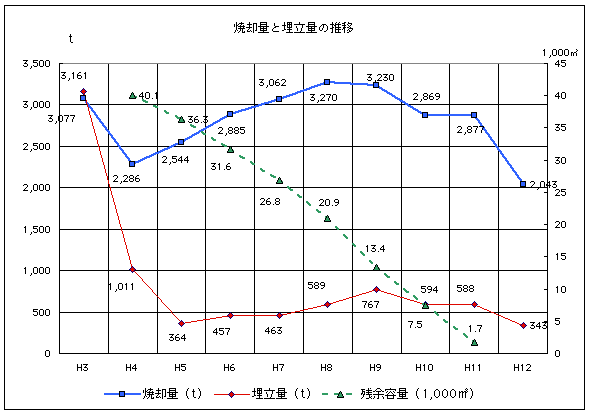
(4)【生ゴミを土に戻す】生ゴミの資源化を推進する
ニセコ町では、平成14年度から堆肥センターの建設を予定しています。これは、家庭や事業所などから出る生ゴミと、下水道処理施設から発生する汚泥、畜産の糞などを原料として堆肥を製造するプラントであり、家庭の台所と農家を結ぶ架け橋の役割を担います。廃棄物の資源化による産業と生活の循環、あるいは、産業と産業の循環の環は、クラスター(ブドウの房のような状態)を形成し、最終的にはゴミゼロを目指します。
しかし、この仕組みは、ニセコ町内だけではなかなか実現できません。この点でも、広域的な結びつきの中で工夫を深める必要があるのです。現在、ごみの広域処理システムが動き出そうとしています。また、尻別川の流域環境を広域的に保全できるような仕組みを検討する動きも始まっています。 このような広域的な動きの中で、小さな循環では解決できない課題が大きな循環に連動することで解決できる仕組みが見えてくるでしょう。そのためのきっかけを、私たちの足許から創り上げていく必要があります。
目標達成に向けた具体的な手だてと主体別行動計画
しかし、この仕組みは、ニセコ町内だけではなかなか実現できません。この点でも、広域的な結びつきの中で工夫を深める必要があるのです。現在、ごみの広域処理システムが動き出そうとしています。また、尻別川の流域環境を広域的に保全できるような仕組みを検討する動きも始まっています。 このような広域的な動きの中で、小さな循環では解決できない課題が大きな循環に連動することで解決できる仕組みが見えてくるでしょう。そのためのきっかけを、私たちの足許から創り上げていく必要があります。
- 目標達成の手だてと重点的な手だて
- 生ゴミの自家堆肥化をすすめます。
- 家庭や事業所における生ゴミの堆肥化と、庭先の土づくりへの還元を進めます。
- 冬の庭先コンポスト化を推進します。
- 堆肥センターによる堆肥づくりを進めます。→【重点的な手だて】
- 目標値:生ゴミ堆肥化率達成目標=100%(自家堆肥化率10%を含む)
目標達成に向けた具体的な手だてと主体別行動計画
| 目標達成の手だて | わたしたち町民の行動項目 | コミュニティの行動項目 | 事業者の行動項目 | 行政(役場)の行動項目 |
| 1.生ゴミの自家堆肥化を進める | ・コンポスターによる生ゴミの堆肥化・自家堆肥の庭土への還元・冬のコンポストづくりのノウハウ開発 | ・集合住宅からの生ゴミ回収の仕組みづくり | ・事業から排出される生ゴミの堆肥化促進・観光客のエコ体験を進めるプログラムを開発する | ・生ゴミを自家堆肥化できない世帯のために集団回収システムを作る |
| 2.家庭や事業所における生ゴミの堆肥化と庭先の土づくりへの還元を進める | ・ガーデニングや家庭菜園への利用促進 | ・地域の公園など公共空地の土づくりへの還元 | ・事業所周辺の花樹への施肥あるいは土づくりに還元 | ・公園などの花樹への施肥あるいは土づくりへの還元 |
| 3.冬の庭先コンポスト化を推進する | ・雪の保温効果と発酵熱を利用して、冬の庭先コンポスターを活用し生ゴミ堆肥を作る | ・堆肥化方法や関連アイデアなどの情報収集と活用法のPRなど | ||
| 4.堆肥センターによる堆肥づくりを推し進める【重点的な手だて】 | ・自家堆肥化できない生ゴミについての回収システムへの参加 | ・自家堆肥化できない生ゴミについての回収システムへの参加 | ・堆肥センターの稼働によるシステム管理・堆肥品質向上のための情報提供 |
- 目標値の背景となる指標O=生ゴミ処理助成制度利用件数の推移(グラフ)
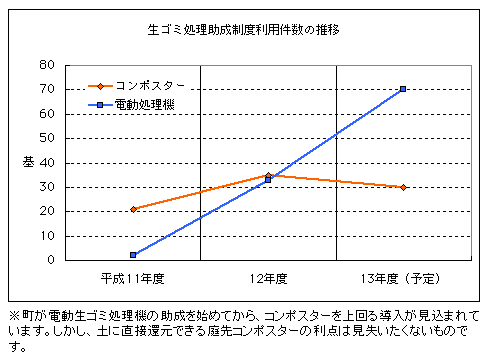
(5)【二酸化炭素の排出を減らす】地球温暖化の原因となる二酸化炭素などの排出を減らす
私たちの生活や経済活動は石油などの化石燃料に依存し、大量の二酸化炭素を大気中に排出しています。これが目に見えない気体であるため日頃その実態を実感することはありませんが、人間活動が生み出す最大の廃棄物なのです。その結果、地球がこれまで保ってきた適度の炭素循環のバランスが崩れ、地球を住み良い環境に保ってきた程良い温室効果のバランスも崩れ、地球温暖化による様々な悪影響が生じます。ですから、私たちの地球温暖化対策は、化石燃料にもとづく資源やエネルギーの消費をいかに押さえ、いかにして代替物、代替エネルギーに転じていくのか、が中心となります。
「環境家計簿」の分析結果によると、ニセコ町ではマイカーのガソリンなど化石燃料による二酸化炭素の排出量が大きな割合となっています。車の使い方を見直すライフスタイルの変更に加えて、町全体の総合的な交通対策が必要です。
目標達成に向けた手だてと主体別の行動項目
「環境家計簿」の分析結果によると、ニセコ町ではマイカーのガソリンなど化石燃料による二酸化炭素の排出量が大きな割合となっています。車の使い方を見直すライフスタイルの変更に加えて、町全体の総合的な交通対策が必要です。
- 目標達成の手だてと重点的な手だて
- 必要最小限の資源量を有効に活用します(省資源)。
- 必要最小限のエネルギーを有効に活用します(省エネルギー)。
- 資源・エネルギー循環の環を補完し、地球環境への負荷を低減します。→【重点的な手だて】
- 地球温暖化ガスを吸収する森林などを守り育てます。
- 目標値:二酸化炭素排出削減率=1991年(平成3年)から6%削減
目標達成に向けた手だてと主体別の行動項目
| 目標達成の手だて | わたしたち町民の行動項目 | コミュニティの行動項目 | 事業者の行動項目 | 行政(役場)の行動項目 |
| 1.必要最少限の資源量を有効に活用する(省資源) | ・節水につとめる・必要なものだけ買って、大切に使うライフスタイルを作る・持続可能性商品(エコ商品)を選択する消費生活に変える・生ゴミの堆肥化をすすめる・フロンや代替フロンを組み込んだ商品を使わないようにする | ・生ゴミ堆肥を地域単位で有効利用する | ・給湯・給水の節水につとめる・持続可能性製品(エコ製品)を選択するグリーン購入を推進する・廃棄物を抑制する生産体制やリサイクルの推進・家畜の糞尿の堆肥化を進め、メタンガスなど温暖化ガスの発生を抑制する・生ゴミの堆肥化をすすめる | ・3R(リユース、リサイクル、リデュース)の推進・LCA(ライフサイクルアセスメント:消費者が製品を使用している時の排出物による環境への影響だけではなく、製品が製造し廃棄されるまで、消費者が実際に見ることができない場所での排出物や資源の消費が環境へ与える影響を評価する方法)による評価システムの構築への検討 |
| 2.必要最少限のエネルギーを有効に活用する(省エネルギー) | ・融雪機やロードヒーティングは必要最小限の使用につとめる・家電機器の節電につとめる・高気密・高断熱住宅の購入、改築につとめる・アイドリングストップなどエコドライブにつとめる・不要不急の自動車利用を控える・低公害車への切り替えにつとめる | ・融雪機や除雪機の共同利用を進める | ・融雪機やロードヒーティングは必要最小限の使用につとめる・コージェネレーションシステム(一つのエネルギー源から熱と電気など二つ以上のエネルギーを取り出し利用する仕組み)などの導入により、事務機器や製造機器の節電や省エネを進める・高気密・高断熱社宅の建設、改築につとめる・アイドリングストップなどエコドライブにつとめる・環境負荷の小さい燃料の使用・不要不急の自動車利用を控える・低公害車への切替えにつとめる・省エネルギー型機器・製品の選択・輸送や物流の効率化と合理化を進める | ・エネルギー利用効率の向上・省エネルギーの手だての推進・低公害車の導入促進を支援・雪冷熱エネルギーの利用促進・時差出勤や情報通信の活用・LCA(ライフサイクルアセスメント)による評価システムの構築への検討 |
| 3.資源循環、エネルギー循環の環を補完し、地球環境への負荷を低減する【重点的な手だて】 | ・ゴミの分別を徹底し、資源回収と再利用化に協力する・太陽エネルギーなど自然エネルギーの導入につとめる・家族や知り合いとの自動車乗り合いの仕組みづくり・公共交通全般のシステムづくりに参加する | ・ゴミの分別を地域単位で徹底し、資源化再利用に協力する・家族や知り合いとの自動車乗り合いの仕組みづくり | ・ゴミの分別を徹底させ、資源回収と再利用化に協力する・太陽エネルギーなど自然エネルギーの導入につとめる・環境ホルモンなど自然生態系に溶け込むことのできない有害物質の放出をなくする・環境にやむを得ず排出する廃棄物の量は、人類圏や生物圏における物質循環のスピードの範囲内で再生できる範囲内(環境容量)にとどめる・公共交通全般のシステムづくりに参加する・ナタネ油など食用廃油によるディーゼル代替燃料の地域生産と利用促進の市場開拓 | ・総合的な廃棄物処理、再資源化のシステム化・自然エネルギーの利用促進支援・雪冷熱エネルギーの利用促進支援・LCA(ライフサイクルアセスメント)による評価システムの構築への検討・町内循環バスの利用促進によるエネルギーの有効利用・公共交通全般について町全体のシステムづくりを進める |
| 4.地球温暖化ガスを吸収する森林などを守り育てる | ・河畔林など植樹への市民参加をすすめる・森林の所有者は、伐採を最小限にとどめる | ・河畔林など植樹への地域参加をすすめる・里山の地域管理をすすめる | ・河畔林など植樹への企業参加をすすめる・森林の所有者は伐採を極力少なくする | ・水辺環境の保全と河畔林の創出・百年の森づくり運動の支援・里山保全活動の支援 |
- 目標値の背景になる指標P=二酸化炭素排出量の予想推移と削減目標値
| 部門 | 領域 | 1886 | 1991 | 1994 | 1996 | 1999 |
| 昭和61年 | 平成3年 | 平成6年 | 平成8年 | 平成11年 | ||
| エネルギー転換部門 | ガス | 7 | 18 | 20 | 24 | 29 |
| 産業部門 | 農林業 | 603 | 562 | 544 | 549 | 469 |
| 鉱業 | 0 | 0 | 0 | 75 | 56 | |
| 建設業 | 101 | 117 | 152 | 196 | 231 | |
| 製造業 | 1,705 | 2,093 | 1,624 | 2,862 | 1,240 | |
| 民生部門 | 家庭系 | 2,470 | 2,188 | 2,545 | 2,550 | 2,603 |
| 業務系 | 1,764 | 1,466 | 1,508 | 1,498 | 1,441 | |
| 運輸部門 | 自動車 | 2,738 | 2,961 | 3,487 | 3,788 | 3,970 |
| 鉄道 | 65 | 35 | 41 | 44 | 47 | |
| 廃棄物部門 | 一般廃棄物 | 16 | 46 | 625 | 878 | 995 |
| 小計 | 9,469 | 9,487 | 10,546 | 12,463 | 11,080 |
| 削減目標案 | 2011 | 目標値の備考 | |||||
| 平成23年 | |||||||
| 目標 | 根拠=1991年比6%削減後の排出量目標値 | 8,918 | 1999年比20%減 | ||||
| 参考目標1 | 根拠=1991年比10%削減後の排出量目標値 | 8,539 | 1999年比23%減 | ||||
| 参考目標2 | 根拠=1999年比10%削減後の排出量目標値 | 9,972 | 1991年比5%増 | ||||
| 参考目標3 | 根拠=1999年比6%削減後の排出量目標値 | 10,415 | 1991年比10%増 | ||||
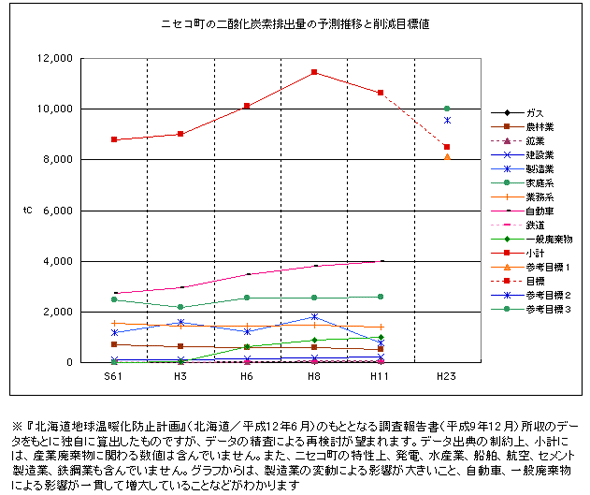
このページの情報に関するお問い合わせ先
- 企画環境課環境モデル都市推進係
- TEL:0136-56-8837
- FAX:0136-44-3500